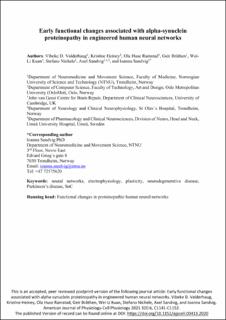| dc.contributor.author | Valderhaug, Vibeke Devold | |
| dc.contributor.author | Heiney, Kristine | |
| dc.contributor.author | Huse Ramstad, Ola | |
| dc.contributor.author | Bråthen, Geir | |
| dc.contributor.author | Kuan, Wei-Li | |
| dc.contributor.author | Nichele, Stefano | |
| dc.contributor.author | Sandvig, Axel | |
| dc.contributor.author | Sandvig, Ioanna | |
| dc.date.accessioned | 2022-02-16T14:08:13Z | |
| dc.date.available | 2022-02-16T14:08:13Z | |
| dc.date.created | 2021-05-13T10:55:55Z | |
| dc.date.issued | 2021-06-18 | |
| dc.identifier.citation | American Journal of Physiology - Cell Physiology. 2021, 320 (6), 1-12. | en_US |
| dc.identifier.issn | 0363-6143 | |
| dc.identifier.issn | 1522-1563 | |
| dc.identifier.uri | https://hdl.handle.net/11250/2979452 | |
| dc.description.abstract | A patterned spread of proteinopathy represents a common characteristic of many neurodegenerative diseases. In Parkinson’s disease (PD), misfolded forms of alpha-synuclein proteins accumulate in hallmark pathological inclusions termed Lewy bodies and Lewy neurites. Such protein aggregates seem to affect selectively vulnerable neuronal populations in the substantia nigra and to propagate within interconnected neuronal networks. Research findings suggest that these proteinopathic inclusions are present at very early timepoints in disease development, even before clear behavioural symptoms of dysfunction arise. In this study we investigate the early pathophysiology developing after induced formation of such PDrelated alpha-synuclein inclusions, in a physiologically relevant in vitro setup using engineered human neural networks. We monitor the neural network activity using multielectrode arrays (MEAs) for a period of three weeks following proteinopathy induction to identify associated changes in network function, with a special emphasis on the measure of network criticality. Self-organised criticality represents the critical point between resilience against perturbation and adaptational flexibility, which appears to be a functional trait in self-organising neural networks, both in vitro and in vivo. We show that although developing pathology at early onset is not clearly manifest in standard measurements of network function, it may be discerned by investigating differences in network criticality states. | en_US |
| dc.description.sponsorship | This work was supported by The Department of Neuromedicine and Movement Science, Faculty of Medicine and Health Sciences, NTNU; The Liaison Committee for Education, Research and Innovation in Central Norway (Samarbeidsorganet HMN, NTNU); and the SOCRATES project (NFR project agreement 270961). The TEM preparation was performed at the Cellular and Molecular Imaging Core Facility (CMIC, NTNU); The AFM and UV-vis spectroscopy were performed by Birgitte Hjelmeland McDonagh at the Norwegian Micro- and Nano-Fabrication Facility (NorFab), Norwegian University of Science and Technology (NTNU). | en_US |
| dc.language.iso | eng | en_US |
| dc.publisher | American Physiological Society | en_US |
| dc.relation.ispartofseries | American Journal of Physiology - Cell Physiology; | |
| dc.subject | Neural networks | en_US |
| dc.subject | Electrophysiology | en_US |
| dc.subject | Plasticity | en_US |
| dc.subject | Neurodegenerative diseases | en_US |
| dc.subject | Parkinson’s disease | en_US |
| dc.subject | Self-organized criticality | en_US |
| dc.subject | SoC | en_US |
| dc.title | Early functional changes associated with alpha-synuclein proteinopathy in engineered human neural networks | en_US |
| dc.type | Peer reviewed | en_US |
| dc.type | Journal article | en_US |
| dc.description.version | acceptedVersion | en_US |
| cristin.ispublished | true | |
| cristin.fulltext | original | |
| cristin.qualitycode | 1 | |
| dc.identifier.doi | https://doi.org/10.1152/ajpcell.00413.2020 | |
| dc.identifier.cristin | 1909862 | |
| dc.source.journal | American Journal of Physiology - Cell Physiology | en_US |
| dc.source.volume | 320 | en_US |
| dc.source.issue | 6 | en_US |
| dc.source.pagenumber | 32 | en_US |
| dc.relation.project | Samarbeidsorganet mellom Helse Midt-Norge og NTNU: 90368100 | en_US |
| dc.relation.project | Norges forskningsråd: 270961 | en_US |
